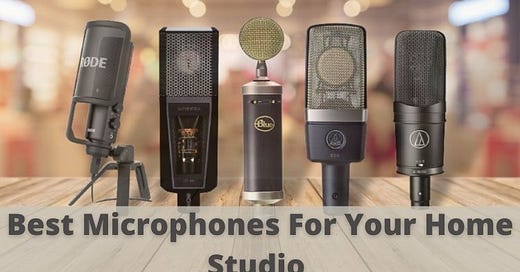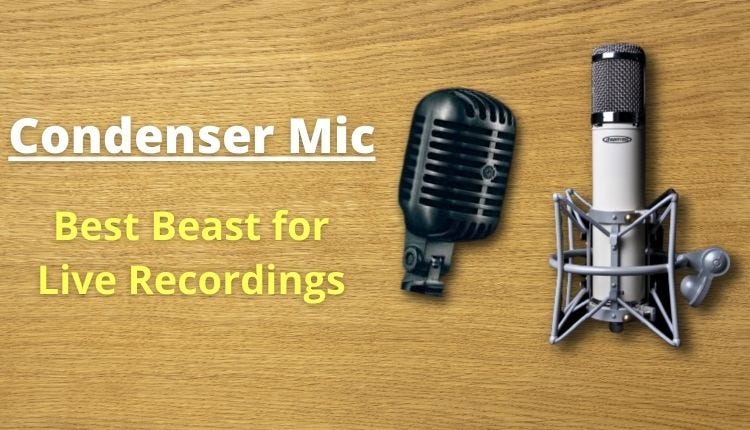When it comes to house recording devices, one of the most important and complicated decisions is purchasing microphones. There are many different kinds of microphones for several different budgets, and the number of options is sometimes overwhelming. Unfortunately, the plenty of microphone alternatives sometimes influences people to buy the wrong microphone for the wrong circumstance. To sprinkle some light on this decision, I’d like to give some clues to help guide you towards the correct one.
Before we go into the various types of microphones that are available, my biggest recommendation is to test out the microphone you like before you purchase it to ensure you like the results. Eventually, you should always make your final decision based on what you discover. There are microphones with similar features and similar price limits to different limits of tastes and styles, so our ears are always the Excellent judge.
There are different types of microphones available in market. It is difficult to test several mics individually at a time. Hence, if you want to check your microphone, online mic test is the best option for you. Testing your mic online will offers you the accurate results of your device. Utilizing them will give you insight of your recording device, so that you can use that data for your next recording projects.
Here are the different varieties of microphones and some possible occasion that you might utilize them:
Condenser Microphones
Condenser microphones are popularly remembered as the most common microphone variety for recording vocals. In fact, if you are sober and you want to achieve commercial quality vocal recordings, you surely should look into getting a condenser microphone.
Amongst all the mic types, condenser microphones grant the widest frequency response from extremely cheap, bassy sounds to high-pitched sounds. Especially, if you are recording high-quality vocals or devices, condensers are your opt-to option for professional-quality sound. They also grant higher sensitivity and cheaper noise than dynamic microphones, which is why they are more favored for recording vocals.
In terms of the price spectrum, condensers tend to be the most costly microphones among their equals. So, you apparently won’t need a condenser microphone if you only demand a microphone for recording videos for tutorials or podcasts.
Dynamic Microphones
Dynamic microphones are excellent for live performances. They are typically constructed rugged and they have internal shock mounting, which enables them to be held. Some dynamic microphones are also commonly used for recording rock music vocals, electric guitars, or drums because they respond accurately to loud conditions. They are much more affordable differentiated from condenser microphones.
Ribbon Microphones
Ribbons typically hold a vintage, smooth, and soft sound. They are bidirectional, which implies that the microphon
e responds to sound entering from the front or back of the mic and does not pick up sound arriving on its sides. For this reason, they are regularly used for hi-fi recording, especially in particular cases where you want to cancel undesired noise among two sources, like in broadcast. It is also possible to record silent instruments with ribbon microphones, such as violin or acoustic guitars, as they capture sound in a more linear manner. Of course, ultimately it depends on your requirements and how you want your recordings done. For a more silent atmosphere, using condenser microphones for softer instruments might be a suitable best.
USB Microphones
USB Microphones are mere, to the point, and an affordable alternative for creating online videos, podcasts, or audiobooks. You surely don’t get the great level of quality you would get from the condenser and dynamic microphones. But USB microphones are simpler to use and budget microphones compared to condenser and dynamic. USB microphones are also growing better in terms of quality every day. There are often some music creators and engineers who claim that it is possible to produce hits music with USB microphones nowadays, that is if you know its correct use. While this is an utter claim even for today, eventually, the outcome of your recording relies on your methodology and demand.
Shotgun Microphones
Shotgun microphones are commonly used in films and on live TV because they possess a unique ability to isolate sound. In noisy conditions, shotgun microphones make it possible to pick up the person's sound talking to the microphone. For this reason, you can usually find them being used in places such as news reporting or wildlife documentation. If you are preparing for something outside of music, like the scenarios above, you can surely use a shotgun microphone to achieve the best outcomes.
Switchable/Multi-Pattern Microphones
These are microphones that can fluctuate between distinct polar patterns, enabling versatile placement. Several of today's USB condenser microphones own this characteristic, allowing you to shift between multiple patterns just by flicking a switch. Others offer the same compatibility by changing the mic head. The benefit that these mics give is obvious, more positioning opportunities and more usage. Just learn to be careful when handling these mics, you don't need to mistakenly damage the extra moving components and circuits that give them their versatility.
Lapel/Lavalier Mic
Lavalier microphones – also remembered as lapel mics or clip-on mics. These are small wired microphones that are broadly used in filmmaking and podcasting. They are perfect for recording conversation as they are attentive and unobtrusive and can be placed near to the mouth while staying out of sight. This guarantees clean, clear audio quality in a variety of recording circumstances, whether that’s reporting to-camera, vlogging, or recording an interview.
There are two major things to think about when using a lapel mic:
1) How to position it
2)How to connect it to your recording device.
Learn what you need to know about them by referring to tutorials on the internet.
There are different types of microphones available at our end, but these seven options are the more popular ones that are being utilized today. Like I said at the start of this article, it is important that you check out different microphones before you purchase them. Also, attempt to get the type that best fits your demand and requirement. The best method to learn more about microphones is to record with more microphones. You can hire out a studio, or you can get microphones from friends and colleagues to see which options do the best job for you. I hope that this article gives you a detailed answer to your microphone query. Good luck and have joy finding the best microphone for audio recording.
In the meantime, tell your friends!






